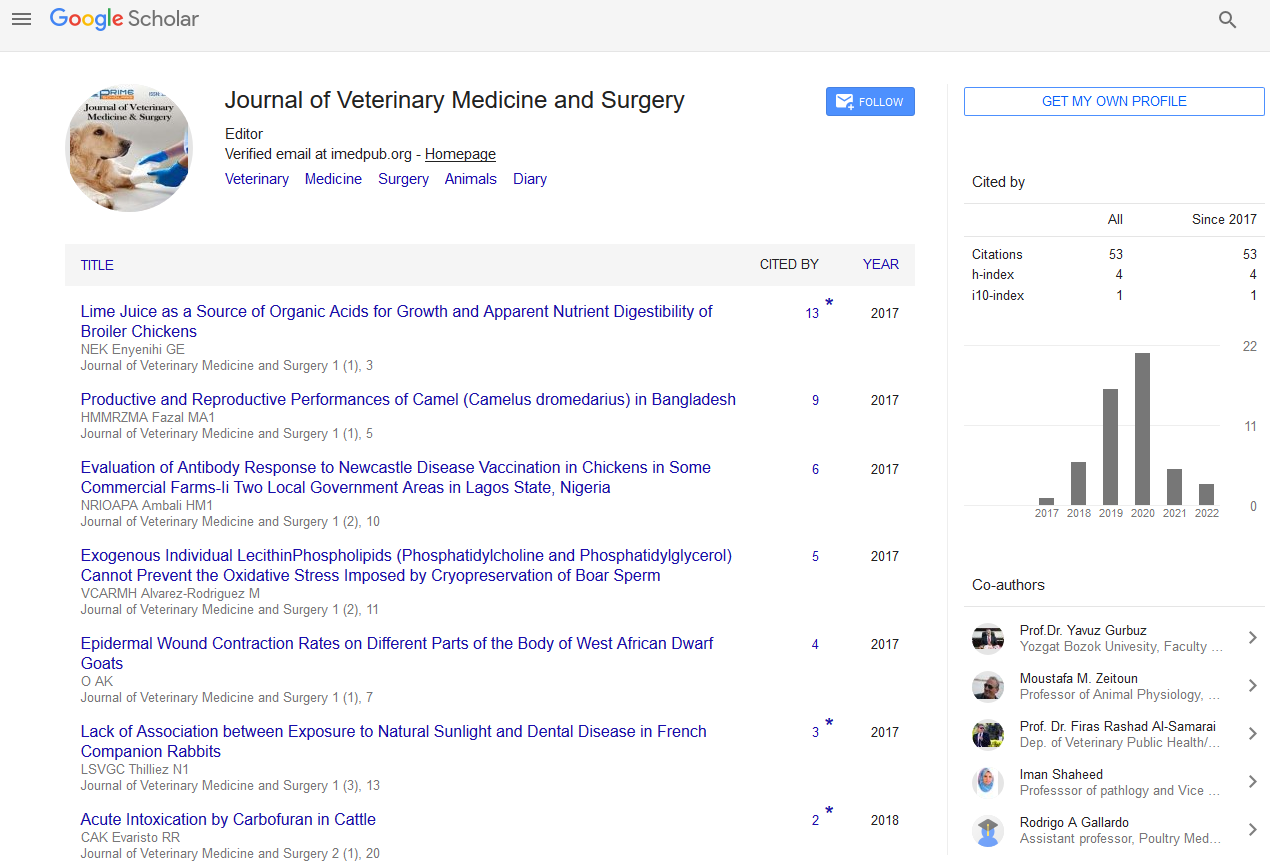Commentary - (2024) Volume 8, Issue 2
The Growing Threat of Antimicrobial Resistance in Veterinary Medicine
Wang Zheng*
Department of Veterinary Medicine, Peking University, China
*Correspondence:
Wang Zheng,
Department of Veterinary Medicine, Peking University,
China,
Email:
Received: 29-May-2024, Manuscript No. IPJVMS-24-20554;
Editor assigned: 31-May-2024, Pre QC No. IPJVMS-24-20554 (PQ);
Reviewed: 14-Jun-2024, QC No. IPJVMS-24-20554;
Revised: 19-Jun-2024, Manuscript No. IPJVMS-24-20554 (R);
Published:
26-Jun-2024, DOI: 10.36648/2574-2868.8.2.14
Introduction
Antimicrobial Resistance (AMR) stands as one of the most
pressing challenges facing modern medicine, not only in human
healthcare but also in veterinary medicine. The emergence of
resistant pathogens among animals has significant implications
for animal health, public health, and the agricultural economy.
This article delves into the causes, consequences, and
potential solutions for AMR in the veterinary context. One
of the primary drivers of AMR is the overuse and misuse of
antibiotics in animals. In many countries, antibiotics are often
administered to livestock not just to treat infections, but also
as growth promoters and prophylactics to prevent disease.
This widespread and often unregulated use creates selective
pressure that encourages the emergence of resistant strains.
Inadequate regulatory frameworks in various regions lead
to unmonitored and improper use of antimicrobials. The
absence of stringent regulations allows for over-the-counter
sales of antibiotics, making them readily accessible for
use without veterinary guidance. The lack of adherence to
proper veterinary practices, such as accurate diagnosis and
appropriate dosing, further exacerbates the problem. Often,
incomplete courses of antibiotics are administered, which fails
to eradicate the infection completely and fosters resistance.
AMR poses a direct threat to animal health by making
infections harder to treat. Common infections can become
life-threatening, leading to increased morbidity and mortality
among livestock and companion animals. The economic impact
is substantial. Resistant infections can lead to longer disease
durations, higher treatment costs, and increased mortality
rates, all of which can cause significant financial losses for
farmers and the agricultural sector at large. Resistant bacteria
can be transmitted from animals to humans through direct
contact, food consumption, or environmental pathways. This
zoonotic transmission bridges the gap between veterinary and
human medicine, underscoring the One Health concept, which
emphasizes the interconnectedness of human, animal, and
environmental health. Strengthening regulatory frameworks to
control the sale and use of antibiotics in veterinary medicine is
crucial. Implementing robust surveillance systems to monitor
antibiotic use and resistance patterns will help in identifying
and mitigating emerging threats. Education campaigns aimed
at veterinarians, farmers, and pet owners about the responsible
use of antibiotics are essential. This includes adhering to
prescribed treatments, avoiding the use of antibiotics for
growth promotion, and implementing alternative measures
such as improved hygiene and vaccination. Investing in
research to develop alternatives to antibiotics, such as
probiotics, prebiotics, and novel antimicrobial agents, can
reduce reliance on traditional antibiotics. Additionally,
breeding for disease-resistant livestock can be a long-term
strategy to mitigate the need for antibiotics. AMR is a global
issue that requires international cooperation. Sharing data,
strategies, and best practices across borders can enhance the
collective ability to combat AMR. Organizations such as the
World Health Organization (WHO) and the World Organization
for Animal Health (OIE) play pivotal roles in coordinating global
efforts. Antimicrobial resistance in veterinary medicine is a
multifaceted issue that necessitates a concerted effort from all
stakeholders, including veterinarians, farmers, policymakers,
and researchers. By implementing comprehensive strategies
that promote responsible antibiotic use, enhance regulatory
oversight, and invest in alternative solutions, we can curb
the rise of AMR and protect the health of both animals and
humans. The battle against antimicrobial resistance is not just
a veterinary issue; it is a public health imperative that requires
immediate and sustained action.
Acknowledgement
None.
Conflict Of Interest
None.
Citation: Zheng W (2024) The Growing Threat of Antimicrobial Resistance in Veterinary Medicine. J Veterinary Med. 8:14.
Copyright: © 2024 Zheng W. This is an open-access article distributed under the terms of the Creative Commons Attribution License, which permits unrestricted use, distribution, and reproduction in any medium, provided the original author and source are credited.

